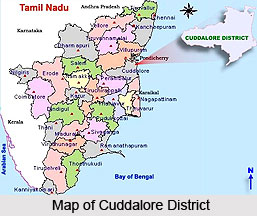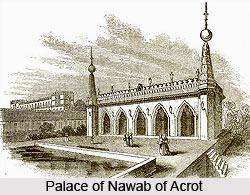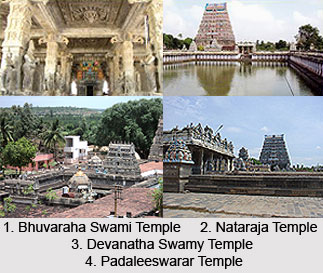 Cuddalore District is one of the administrative districts of Tamil Nadu. This is well known for the world famous Lord Natarajan Temple. Cuddalore city is the district headquarters. This is the original place of the sculpture of Nataraj. Cuddalore District is known for its unique specialties. Like for instance, Cuddalore District is considered as the abode of Cosmic Dancer. The historic importance of this District can be mentioned properly as it has played role since the time of `Idicasam`. This place is also famous for Lignite and Coal Mine. Lignite that is found in abundance is actually a treasure for the community. Like this out of Coal Mine heavy power and electricity is produced and distributed throughout the country. Cashew nut is known as the rich crop of this district. Maximum export is being done from this district and it is known as one of the important commercial crops of this district.
Cuddalore District is one of the administrative districts of Tamil Nadu. This is well known for the world famous Lord Natarajan Temple. Cuddalore city is the district headquarters. This is the original place of the sculpture of Nataraj. Cuddalore District is known for its unique specialties. Like for instance, Cuddalore District is considered as the abode of Cosmic Dancer. The historic importance of this District can be mentioned properly as it has played role since the time of `Idicasam`. This place is also famous for Lignite and Coal Mine. Lignite that is found in abundance is actually a treasure for the community. Like this out of Coal Mine heavy power and electricity is produced and distributed throughout the country. Cashew nut is known as the rich crop of this district. Maximum export is being done from this district and it is known as one of the important commercial crops of this district.
Location of Cuddalore District
The geographical position of Cuddalore District is north latitude between 11 degree 11 minutes and 12 degree 35 minutes and east longitude between 78 degree 38 minutes and 80 degree. The total area of Cuddalore district is 3678 sq kms. As per 2001 Census, total population of Cuddalore District is 22,85,395, out of which male population is 11,50,908 and female population is 15,31,034. Total number of literate population is 14, 20,488.
History of Cuddalore District
 This district is a primitive one. History of the systematic administration of the Land Revenue of erstwhile South Arcot District begins with the acquisition from the Nawab in 1801, when Captain Graham was appointed to take charge of the district lying between Palar and Portonovo rivers and become the first Collector South Arcot. In Indian Puranas, this district is described as part of Sri Rama Kshetra. Historic evidences reveal that the name `Arcot` was derived from Tamil `Aaru kadu`, which means six forests which was said to be the abode of six rishis. In the year 1808, however Arcot, Vellore, Thiruvathur, Polur, and Arani Jagir were transferred to North Arcot and Wandiwash to Cheingleput. In 1816, Puducherry was finally restored to the French and erstwhile South Arcot assumed practically its position. The present Cuddalore District has been formed on 30th September, 1993.
This district is a primitive one. History of the systematic administration of the Land Revenue of erstwhile South Arcot District begins with the acquisition from the Nawab in 1801, when Captain Graham was appointed to take charge of the district lying between Palar and Portonovo rivers and become the first Collector South Arcot. In Indian Puranas, this district is described as part of Sri Rama Kshetra. Historic evidences reveal that the name `Arcot` was derived from Tamil `Aaru kadu`, which means six forests which was said to be the abode of six rishis. In the year 1808, however Arcot, Vellore, Thiruvathur, Polur, and Arani Jagir were transferred to North Arcot and Wandiwash to Cheingleput. In 1816, Puducherry was finally restored to the French and erstwhile South Arcot assumed practically its position. The present Cuddalore District has been formed on 30th September, 1993.
Administration of Cuddalore District
Administration of Cuddalore District include three revenue divisions, six revenue taluks, 32 revenue firkas and 896 revenue villages.
Economy of Cuddalore District
Economy of Cuddalore District is dependent on agriculture. Total cultivated area of the district is around 2, 72,159 Hectares. A huge portion of the cultivated land is used in rice production. The other important crops that are produced in the district abundantly include millets, pulses, sugarcane, groundnut, cotton, etc. There are number of fisheries present in this locality. The district has several industries including small scale cottage industries. Economy of the district also depends on animal husbandry. There are many rivers and lakes, which helps to maintain the irrigation properly in the district. The important ones are Gadilam, Pennar, Vellar, Veeranam, Perumal Eri, and Wellington Lake.
 Education in Cuddalore District
Education in Cuddalore District
The literacy rate is in a higher position here in Cuddalore District. There is one university present in the district whereas there are around eight arts and science colleges, near about one medical college, around four engineering colleges and one agricultural college. Nearly 1245 primary schools are also present in the district. Further, there are around nine teacher-training colleges present in Cuddalore District.
Tourism in Cuddalore District
There are several tourist spots present in Cuddalore District. Tourism in Cuddalore District offers visits to several religious as well as historical sites. Natraja Temple, Padaleeswarar Temple, Devanatha Swami Temple and Bhuvaraha Swami Temple are some of the main tourist sites of this district.
Cuddalore District is well connected by roadways; railways and also seaways serve here properly.






